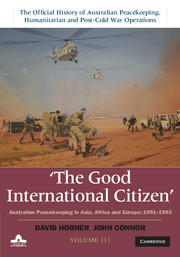Book contents
- Frontmatter
- Contents
- Maps
- Preface
- Chronology 1989–99
- Abbreviations
- Part 1 Strategy and policy
- Part 2 Cambodia
- 3 From Angkor Wat to Pol Pot
- 4 Law and order on the border
- 5 An Australian peace proposal
- 6 First into Phnom Penh
- 7 The roadblock
- 8 Change in plan
- 9 ‘Democracy's surprise triumph’
- 10 Developing Operation Banner
- 11 Winding up Operation Banner
- Part 3 Western Sahara
- Part 4 Former Yugoslavia
- Part 5 Watch on Iraq
- Appendix A United Nations Security Council resolutions
- Appendix B Major office bearers, 1991–99
- Bibliography
- Index
- Plate section
- References
6 - First into Phnom Penh
The Australian Army contingent in the UN Advance Mission in Cambodia, 1991–92
from Part 2 - Cambodia
Published online by Cambridge University Press: 12 May 2022
- Frontmatter
- Contents
- Maps
- Preface
- Chronology 1989–99
- Abbreviations
- Part 1 Strategy and policy
- Part 2 Cambodia
- 3 From Angkor Wat to Pol Pot
- 4 Law and order on the border
- 5 An Australian peace proposal
- 6 First into Phnom Penh
- 7 The roadblock
- 8 Change in plan
- 9 ‘Democracy's surprise triumph’
- 10 Developing Operation Banner
- 11 Winding up Operation Banner
- Part 3 Western Sahara
- Part 4 Former Yugoslavia
- Part 5 Watch on Iraq
- Appendix A United Nations Security Council resolutions
- Appendix B Major office bearers, 1991–99
- Bibliography
- Index
- Plate section
- References
Summary
When the Australian members of the UN Advance Mission in Cambodia (Unamic) arrived in Phnom Penh in November 1991, they found a people sick, impoverished and traumatised after decades of conflict. Everyone had dysentery. Even the bottled water in the city's best hotel contained the E. coli bacteria. In some rural districts outside the control of any faction, the children were starving and riddled with worms. Along the Thai border, up to twenty-five people were dying every day from a malaria strain resistant to the only locally available medication. In other areas, half the people had tuberculosis. The economy was decrepit. Inflation was rampant, and the public service was on the verge of collapse. At Angkor Wat, unpaid soldiers eked a living extorting money from a trickle of foreign tourists. In this despair, there were two sources of hope. Prince Sihanouk's return to Phnom Penh brought joy to his loyal and devout subjects. The Prince's favourite 1950s jazz music was heard everywhere on radio and in dance halls; his films were constantly seen on television. Men began wearing suits again after years of communist austerity, during which they were required to wear proletarian clothing. The Cambodian people were just as welcoming to the UN mission. Sihanouk's return had seen the revival of a nostalgic past, but the peacekeepers’ arrival offered the possibility of a new future.
- Type
- Chapter
- Information
- The Good International CitizenAustralian Peacekeeping in Asia, Africa and Europe 1991–1993, pp. 112 - 137Publisher: Cambridge University PressPrint publication year: 2014

